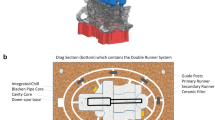Abstract
The toothed chain joint is a major component in heavy lifting equipment. They are usually fabricated using casting; however, residual casting defects in the joint tend to reduce mechanical strength and can lead to crack formation and creep following long-term usage. They also pose a safety hazard. In this study, numerical simulation was used to optimize the investment casting parameters for toothed chain joints of SNCM220 alloy. Optimization was based on predictions of cavity shrinkage, as determined using the retained melt modulus and probabilistic defect parameter, and porosity defects, estimated using the combined defect parameter-Niyama criterion. Preliminary simulation and experiment results were used to guide the establishment of two casting schemes: CaseA (reducing the length of the runner and removing the auxiliary inlets on both sides) and CaseB (increasing the number of inlets). Further simulations were conducted wherein the runner was covered with cotton insulation (6-mm thick). Virtual thermo-dynamical sensors were also used to determine the rate and direction of solidification in the mold cavity. Under nondestructive testing based on X-ray analysis, the investment castings fabricated under optimal conditions exhibited none of the detrimental defects commonly associated with this type of casting.














Similar content being viewed by others
References
Kuo JK, Huang PH, Lai HY, Chen JR (2017) Optimal gating system design for investment casting of 17-4PH stainless steel enclosed impeller by numerical simulation and experimental verification. Int J Adv Manuf Technol 92:1093–1103
Wu M, Augthun M (2001) Application of laser measuring, numerical simulation and rapid prototyping to titanium dental castings. Dent Mater 17:102–108
Kuo JK, Huang PH, Guo MJ (2017) Removal of CrMo alloy steel components from investment casting gating system using vibration-excited fatigue failure. Int J Adv Manuf Technol 89:101–111
Zhang XP, Chen G (2005) Computer simulation of the solidification of cast titanium dental prostheses. J Mater Sci 40:4911–4916
Huang PH, Chen YT, Wang BT (2014) An effective method for separating casting components from the runner system using vibration-induced fatigue damage. Int J Adv Manuf Technol 74:1275–1282
Huang PH, Guo MJ (2015) A study on the investment casting of 17-4PH stainless steel helical impeller of centrifugal pump. Mater Res Innov 19(S9):77–81
Zhou JX, Liu RX, Chen LL, Liao DM (2004) Applications of foundry CAE in steel casting. Hot Work Technol 42(15):80–85
Zeng L, Zhao JH, Song G (2011) Application of Niyama criterion in the shrinkage porosity prediction of metal gravity casting aluminum alloy motorcycle wheel. Special Casting & Nonferrous Alloys 31(9):807–811
Niyama E, Uchida T, Morikaya M, Siato S (1982) A method of shrinkage prediction and its application to steel casting practice. Am Foundrymen’s Soc Int Cast Met J 7(3):52–63
Fu PX, Kang XH, Ma YC, Liu K, Li DZ, Li YY (2008) Centrifugal casting of TiAl exhaust valves. Intermetallics 16(2):130–138
Zhang ZX, Huang F, Meng WN, Liao XY (2015) Casting defect analysis and process improvement of steam generator support based on AnyCasting. Foundry 64(12):1239–1246
Huang PH, Luo JY, Hung SC, Lin CJ, Cheng HH (2014) Optimal pouring system design for investment casting of cladding thin-plate heater using metallic mold flow analyses. Appl Mech Mater 627:46–49
Huang PH, Kuo JK, Fang TH, Wu WR (2018) Numerical simulation and design of casting system for stainless steel exhaust manifold. MATEC Web of Conferences 185:00008
Kim KH, Hwang JH, Oh JS, Lee DH, Kim IH, Yoon YC (2005) Prediction of shrinkage defect in steel casting for marine engine cylinder cover by numerical analysis. 67th World Foundry Congress 209:1–9
Raza M, Irwin M, Fagerström B (2015) The effect of shell thickness, insulation and casting temperature on defects formation during investment casting of Ni-base turbine blades. Arch Foundry Eng 15(4):115–124
Huang PH, Lin CJ (2015) Computer-aided modeling and experimental verification of optimal gating system design for investment casting of precision rotor. Int J Adv Manuf Technol 79:997–1006
User manual of AnyCasting, version 6.0 (2001) AnyCasting, Co., Ltd. Gangseo-gu, Seoul City
Huang PH, Shih LKL, Lin HM, Chu CI, Chou CS (2019) Novel approach to investment casting of heat-resistant steel turbine blades for aircraft engines. Int J Adv Manuf Technol 104:2911–2923. https://doi.org/10.1007/s00170-019-04178-z
Hirt CW, Nichols BD (1981) Volume of fluid (VOF) method for the dynamics of free boundaries. J Comp Phys 39:201–225
Nichols, BD, Hirt CW (1975) Methods for calculating multidimensional, transient free surface flows past bodies. Proc of the First International Conf on Num Ship Hydrodynamics, Gaithersburg, ML, Oct. 20–23
Kuo JK, Huang PH, Lai HY, Wu WJ (2019) Design of casting systems for stainless steel exhaust manifold based on defective prediction model and experimental verification. Int J Adv Manuf Technol 100:529–540
Nichols BD, Hirt CW (1980) Numerical simulation of BWR ventclearing hydrodynamics. Nucl Sci Eng 73(2):196–209
Chen S, Raad DB (1997) The surface marker and micro-cell method. Int J Numer Methods Fluids 25:749–778
Acknowledgments
The authors gratefully acknowledge the support provided for this research by Hei Full Industrial Co., LTD, Taiwan, for their assistance in the casting experiments of toothed chain joints.
Funding
This study received financial support from the Ministry of Science and Technology, R.O.C. under grants MOST 108-2221-E-224-034 and MOST 107-2622-E-224-013-CC3.
Author information
Authors and Affiliations
Corresponding author
Additional information
Publisher’s note
Springer Nature remains neutral with regard to jurisdictional claims in published maps and institutional affiliations.
Rights and permissions
About this article
Cite this article
Huang, PH., Cheng, CY., Huang, WJ. et al. Optimal design of investment casting system for toothed chain joint: computer simulations and experimental verification. Int J Adv Manuf Technol 106, 1931–1943 (2020). https://doi.org/10.1007/s00170-019-04765-0
Received:
Accepted:
Published:
Issue Date:
DOI: https://doi.org/10.1007/s00170-019-04765-0



